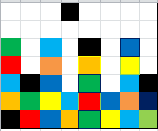Title:
Topic link: LUOGU Long-necked Deer Placement
Explanation:
I just looked like a search. Then I went to search optimization, pruning, thinking about what A* was, and then I saw a sentence on the topic:
Then,,, (without words)
I changed my mind and wanted to build a map directly, but it was really not very good at it. I looked at the problem. I drew a picture according to the idea of parity. Here is sample 2. According to parity, we can build a whole picture (repeating the outline of the frame, and only drawing the first two lines).
So just build edges directly according to parity, even sequence belongs to X set, odd sequence belongs to Y set (because even + odd = odd) so it must be a bipartite graph. After building the graph, we can find the maximum independent set of the bipartite graph, that is, all points - maximum matching.
(the first point I've been in T for a long time, the card is often serious, and I just started O2O_{2}O2.
Code:
// luogu-judger-enable-o2 #include<bits/stdc++.h> using namespace std; inline int read() { int s=0,w=1;char ch=getchar(); while(ch<'0'||ch>'9'){if(ch=='-')w=-1;ch=getchar();} while(ch<='9'&&ch>='0')s=s*10+ch-'0',ch=getchar(); return s*w; } const int sea=220; const int pool=50005; int dx[8]={3,3,1,-1,-3,-3,1,-1}; int dy[8]={1,-1,3,3,1,-1,-3,-3}; int n,m,k,ans,a[sea][sea],v[pool],pre[pool]; int tot=0,last[pool]; struct see{int ver,next;}e[1000000];//Neighborhood tables are used here, but two-dimensional arrays cannot be saved. void add(int x,int y){e[++tot].next=last[x],e[tot].ver=y;last[x]=tot;} int f(int x,int y){return (x-1)*m+y;}//Processing point mark bool hgry(int x) { for(int i=last[x];i;i=e[i].next) { int y=e[i].ver; if(v[y]) continue; v[y]=1; if(!pre[y]||hgry(pre[y])){pre[y]=x;return 1;} } return 0; } int main() { n=read(); m=read(); k=read();ans=n*m; for(int i=1;i<=k;i++) { int x=read(),y=read(); a[x][y]=1; } memset(pre,0,sizeof(pre)); for(int i=1;i<=n;i++) for(int j=1;j<=m;j++) if(i%2==0&&!a[i][j])//Edge building according to parity for(int k=0;k<8;k++) { int x=i+dx[k],y=j+dy[k]; if(x<=n&&x>0&&y<=m&&y>0&&!a[x][y]) add(f(i,j),f(x,y)); } // The maximum independent set can be obtained directly. int s=0; for(int i=1;i<=f(n,m);i++) { memset(v,0,sizeof(v)); if(hgry(i)) s++; } printf("%d\n",ans-s-k);//(Don't forget to subtract the points you can't put in) return 0; }